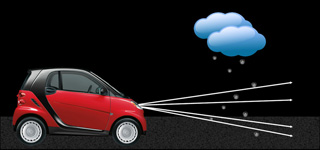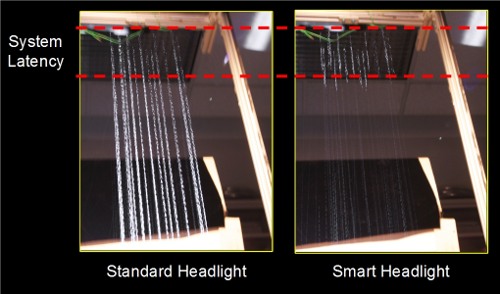 |
| August 07, 2012 | Volume 08 Issue 29 |
Designfax weekly eMagazine
Archives
Partners
Manufacturing Center
Product Spotlight
Modern Applications News
Metalworking Ideas For
Today's Job Shops
Tooling and Production
Strategies for large
metalworking plants
New smart headlight system will have drivers seeing through the rain
Drivers can struggle to see when driving at night in a rainstorm or snowstorm, but a smart headlight system invented by researchers at Carnegie Mellon University's Robotics Institute can improve visibility by constantly redirecting light to shine between particles of precipitation.

The system, demonstrated in laboratory tests, prevents the distracting and sometimes dangerous glare that occurs when headlight beams are reflected by precipitation back toward the driver.
"If you're driving in a thunderstorm, the smart headlights will make it seem like it's a drizzle," says Srinivasa Narasimhan, associate professor of robotics.
The system uses a camera to track the motion of raindrops and snowflakes and then applies a computer algorithm to predict where those particles will be just a few milliseconds later. The light projection system then adjusts to deactivate light beams that would otherwise illuminate the particles in their predicted positions.
"A human eye will not be able to see that flicker of the headlights," Narasimhan says. "And because the precipitation particles aren't being illuminated, the driver won't see the rain or snow either."

To people, rain can appear as elongated streaks that seem to fill the air. To high-speed cameras, however, rain consists of sparsely spaced, discrete drops. That leaves plenty of space between the drops where light can be effectively distributed if the system can respond rapidly, Narasimhan says.
In their lab tests, Narasimhan and his research team demonstrated that their system could detect raindrops, predict their movement, and adjust a light projector accordingly in 13 msec. At low speeds, such a system could eliminate 70% to 80% of visible rain during a heavy storm, while losing only 5% or 6% of the light from the headlamp.
To operate at highway speeds and to work effectively in snow and hail, the system's response will need to be reduced to just a few milliseconds, Narasimhan says. The lab tests have demonstrated the feasibility of the system, however, and the researchers are confident that the speed of the system can be boosted.
The test apparatus, for instance, couples a camera with an off-the-shelf DLP projector. Road-worthy systems likely would be based on arrays of light-emitting diode (LED) light sources in which individual elements could be turned on or off, depending on the location of raindrops. New LED technology could make it possible to combine LED light sources with image sensors on a single chip, enabling high-speed operation at low cost.
Narasimhan's team is now engineering a more compact version of the smart headlight that in coming years could be installed in a car for road testing.
Though a smart headlight system will never be able to eliminate all precipitation from the driver's field of view, simply reducing the amount of reflection and distortion caused by precipitation can substantially improve visibility and reduce driver distraction. Another benefit is that the system also can detect oncoming cars and direct the headlight beams away from the eyes of those drivers, eliminating the need to shift from high to low beams.
"One good thing is that the system will not fail in a catastrophic way," Narasimhan said. "If it fails, it is just a normal headlight."
This research was sponsored by the Office of Naval Research, the National Science Foundation, and the Samsung Advanced Institute of Technology and Intel Corp.
The Robotics Institute is part of Carnegie Mellon's School of Computer Science.
Source: Carnegie Mellon University
Published August 2012
Rate this article
View our terms of use and privacy policy
